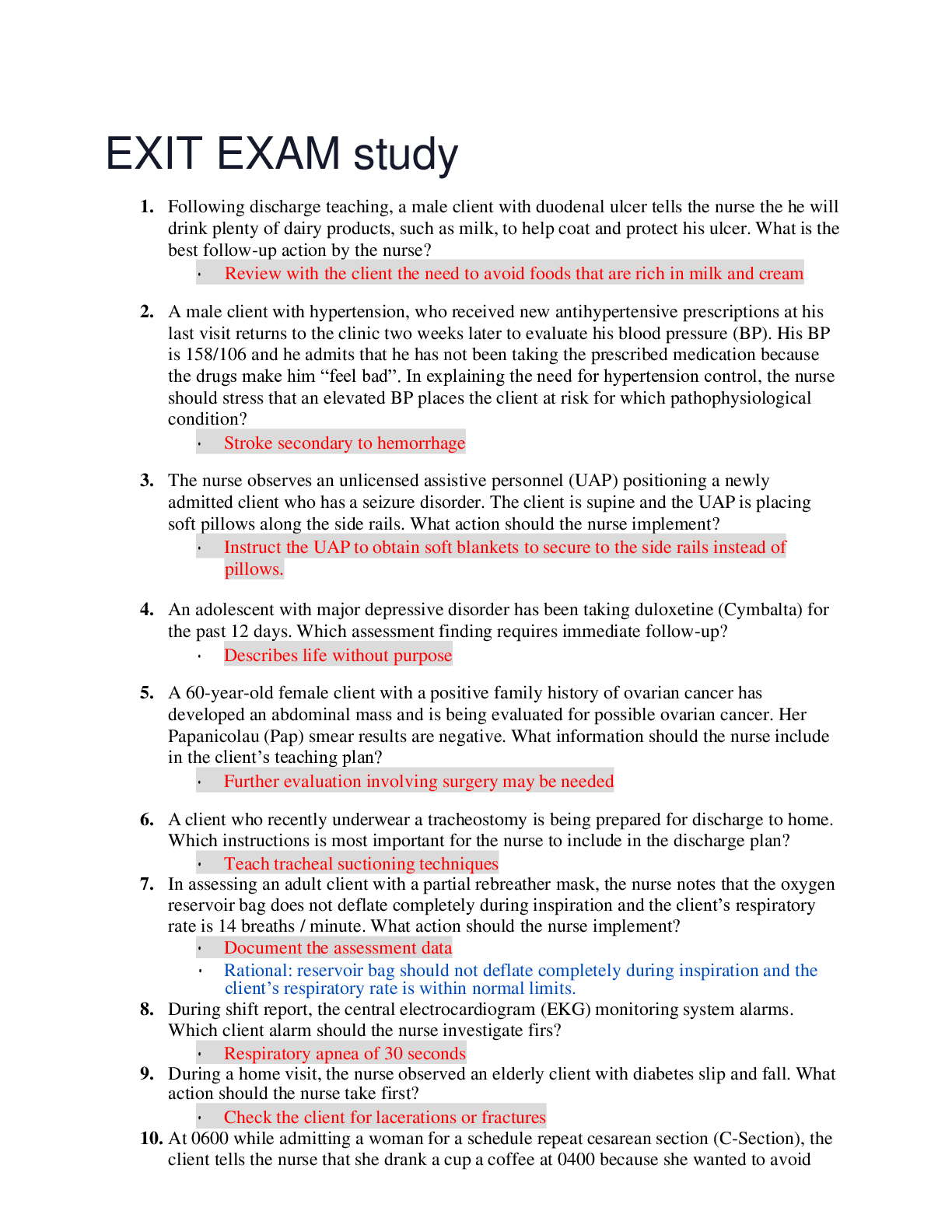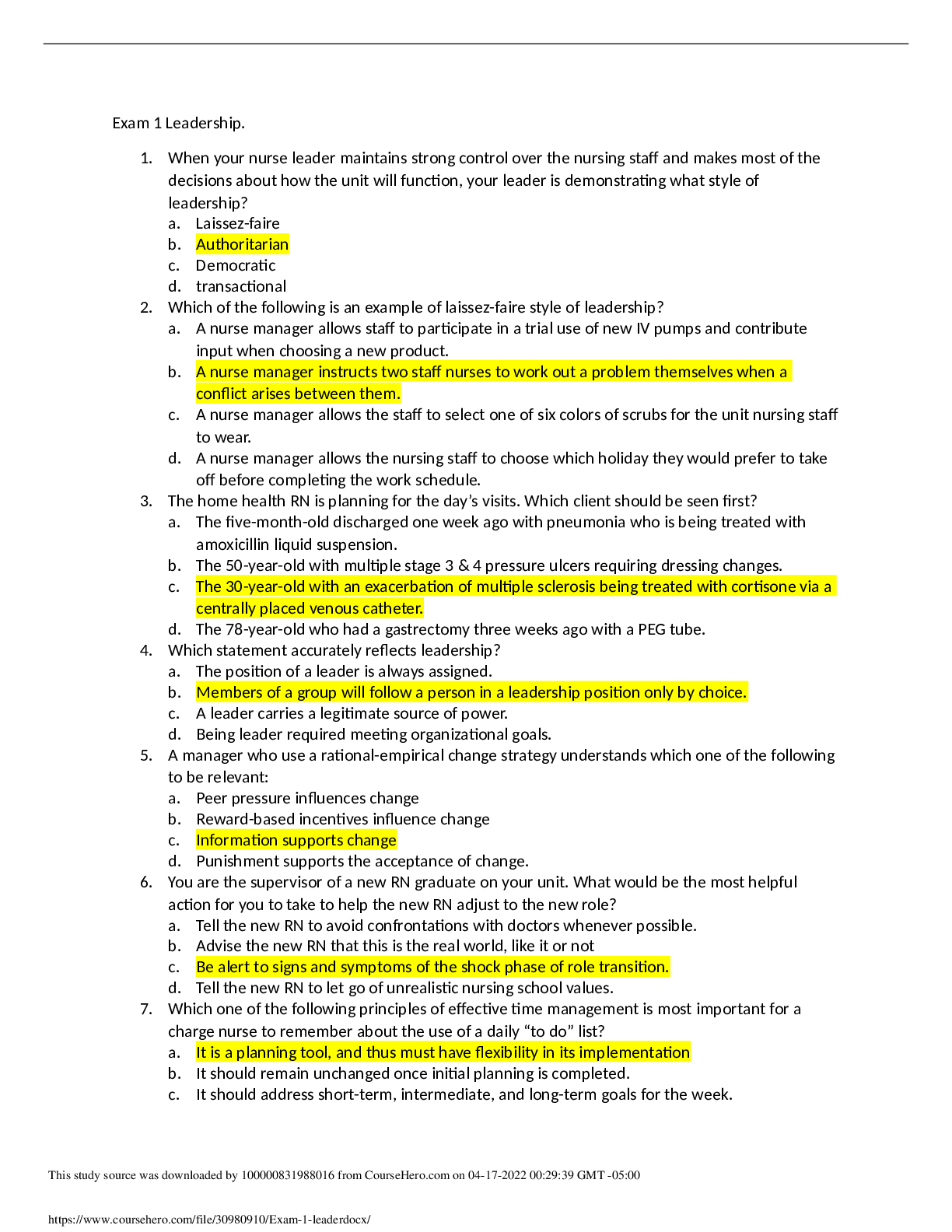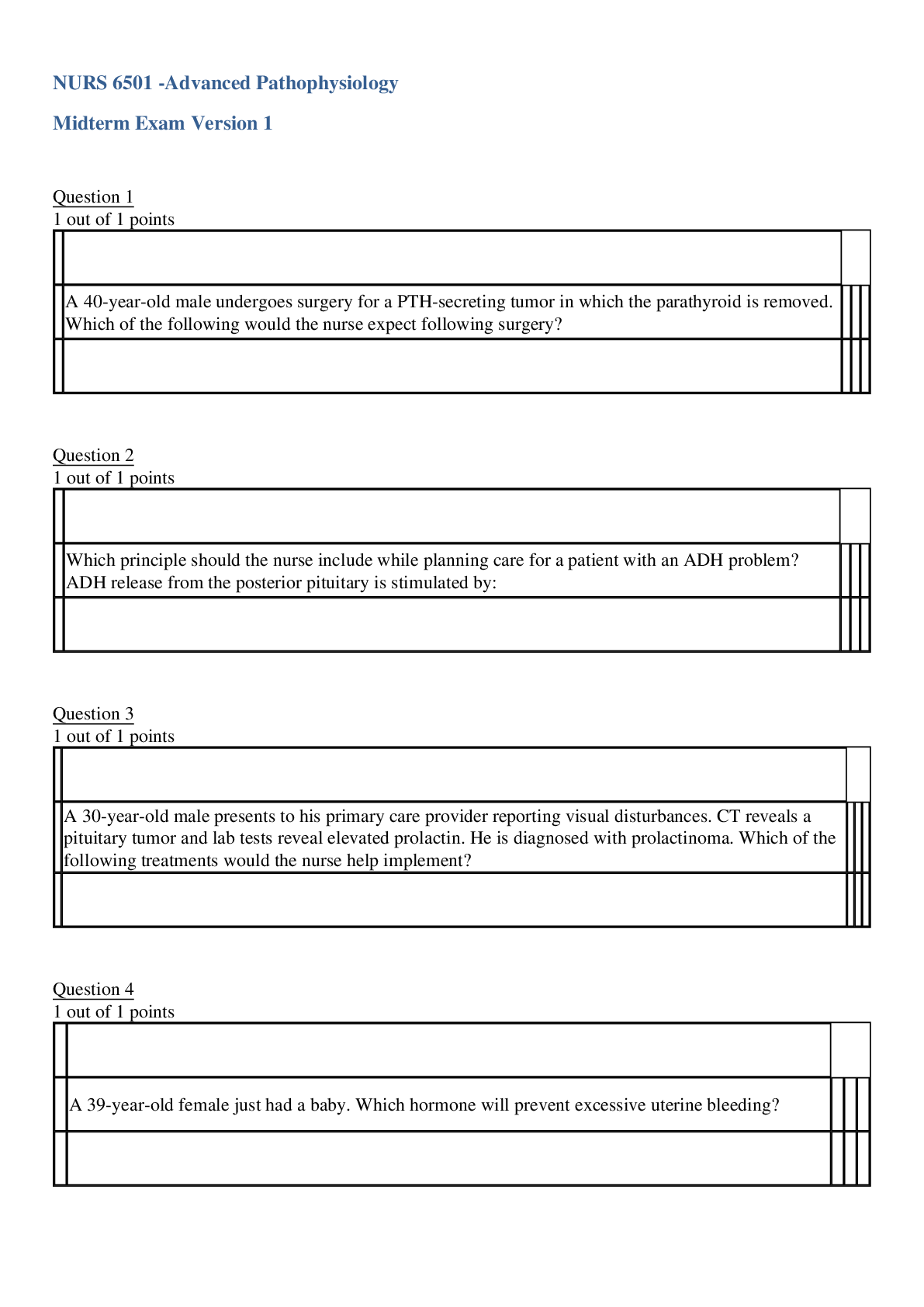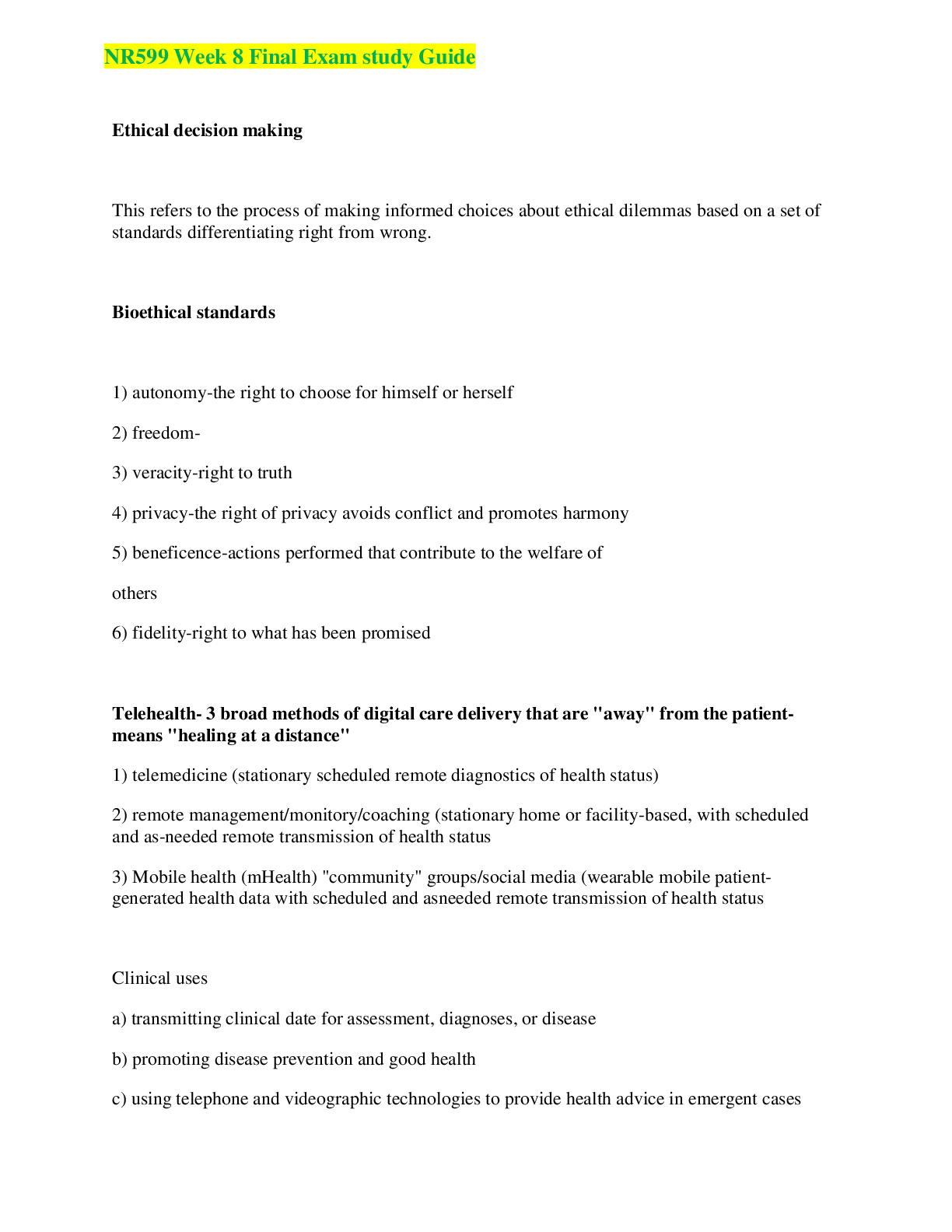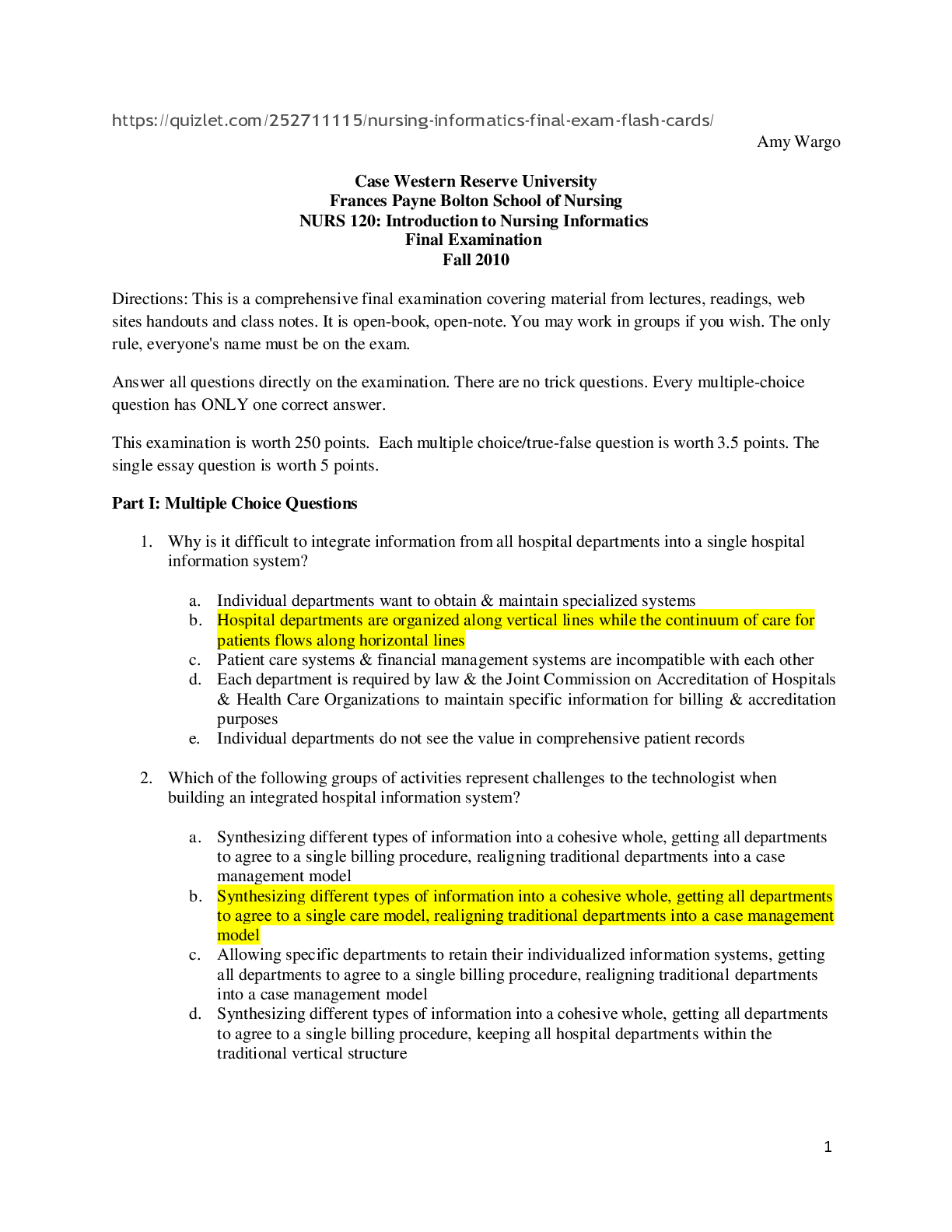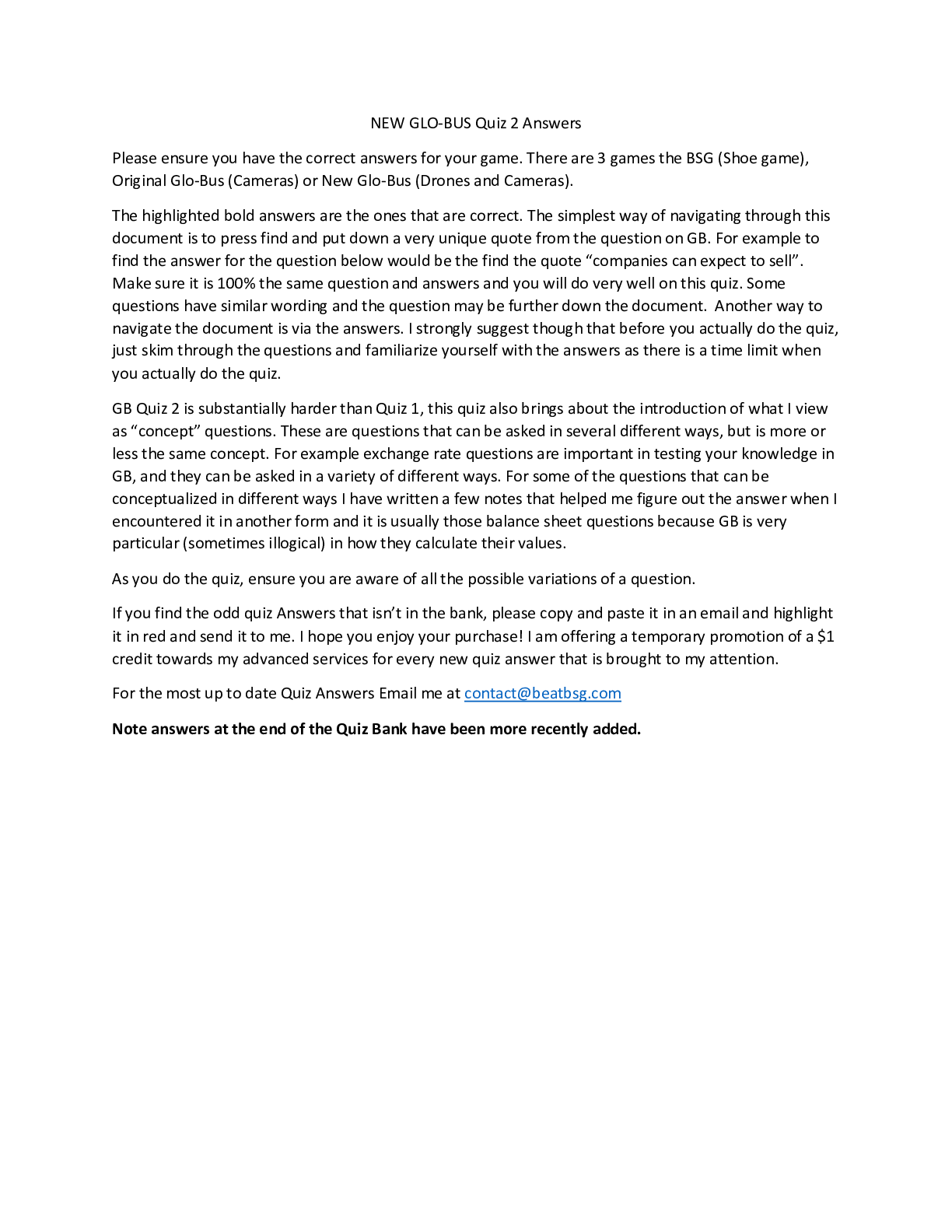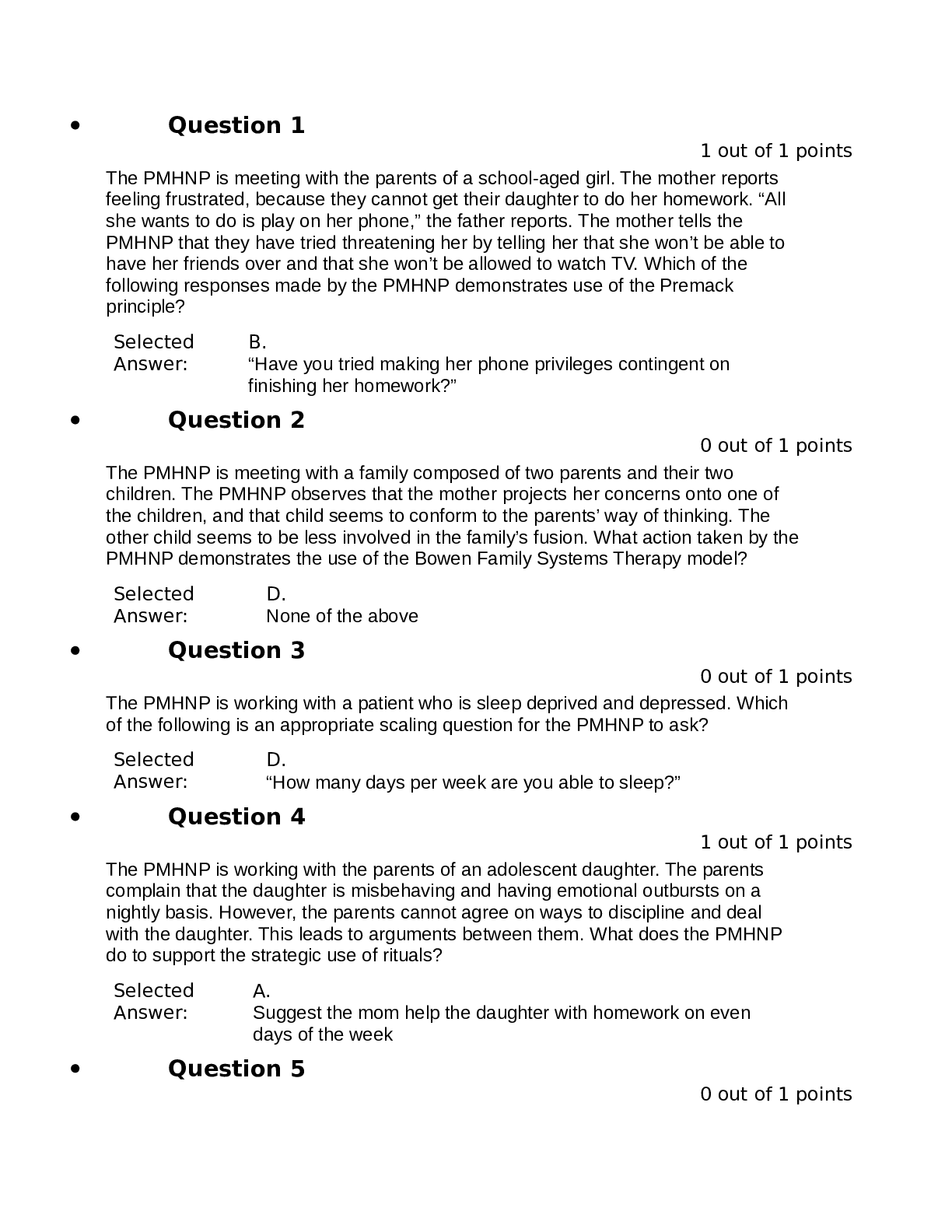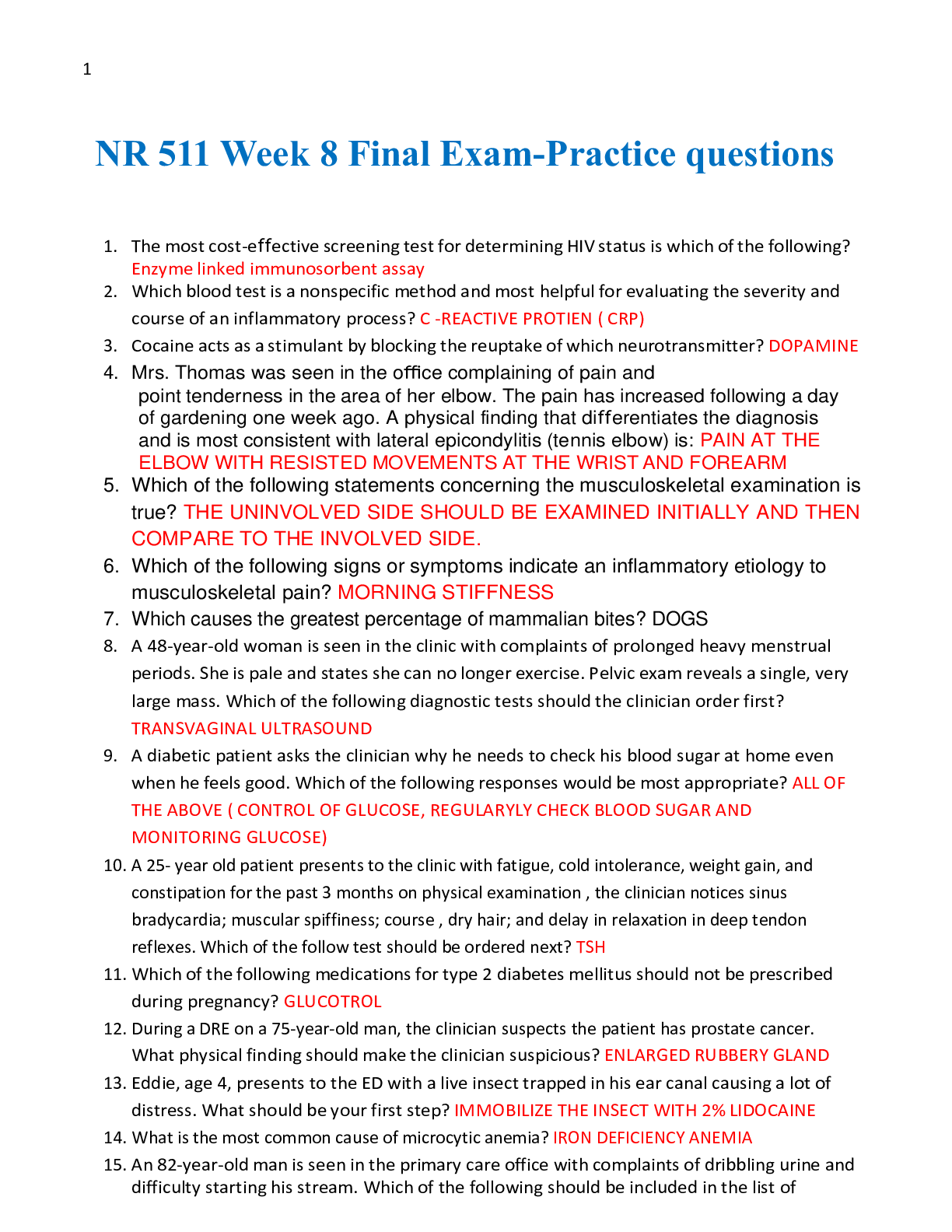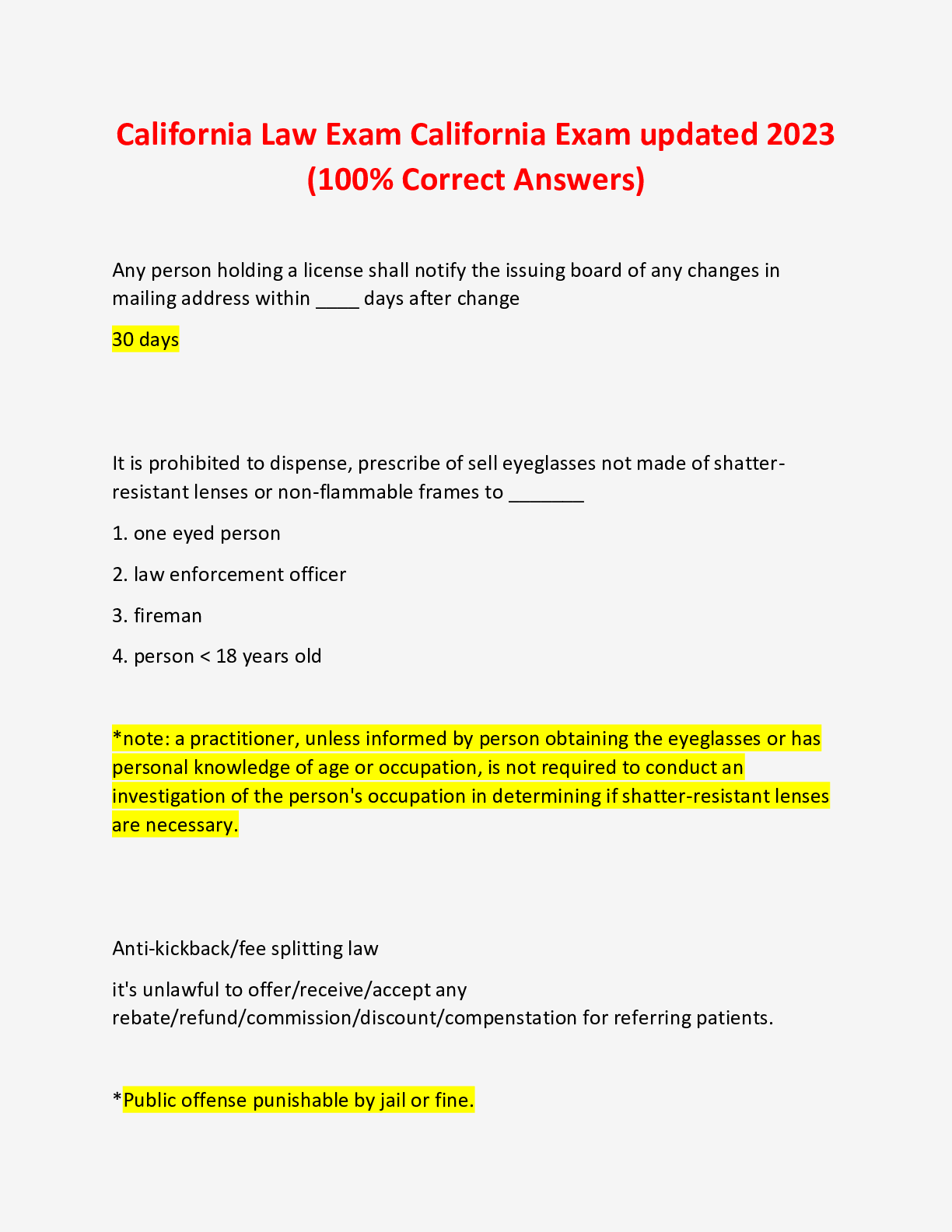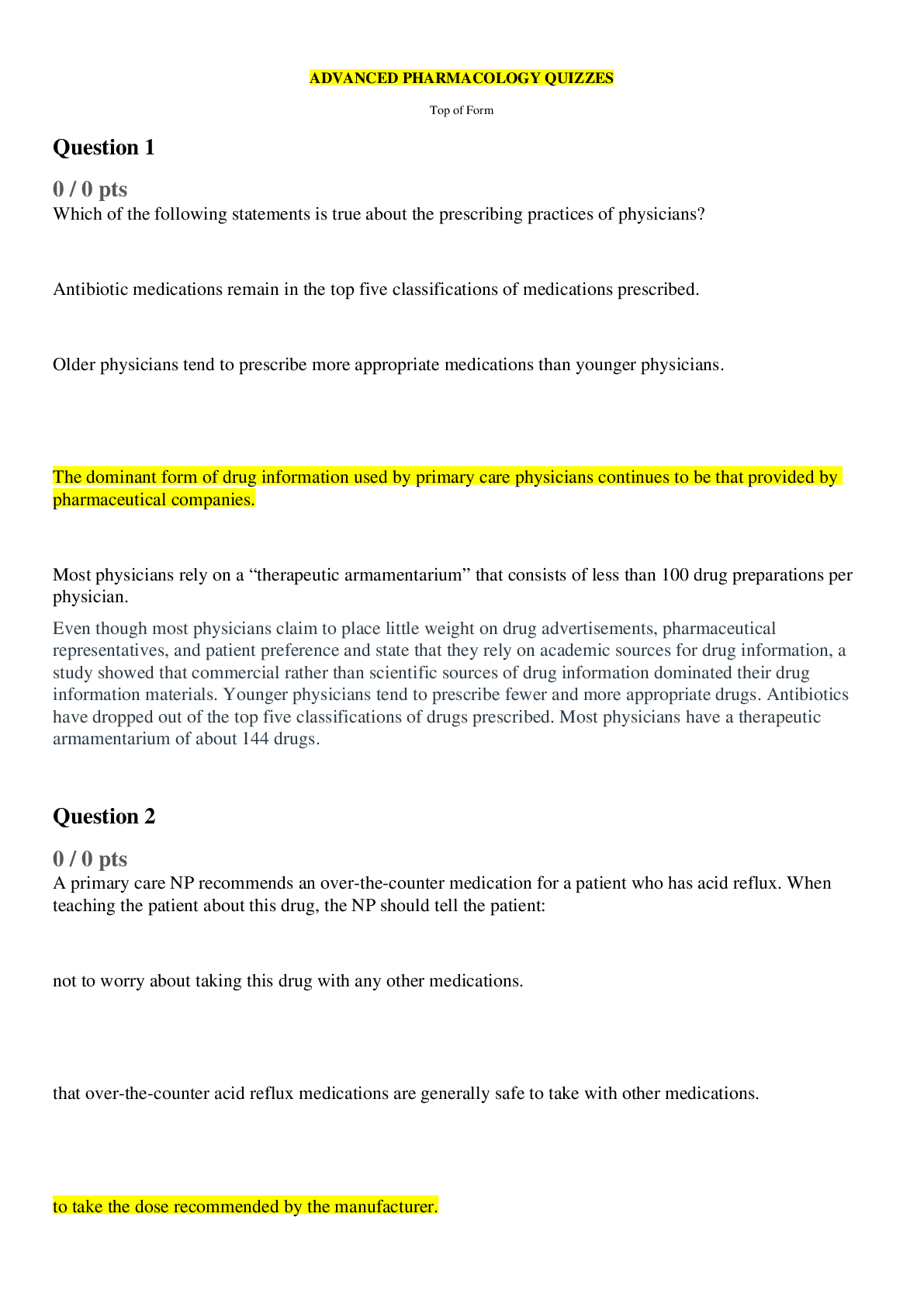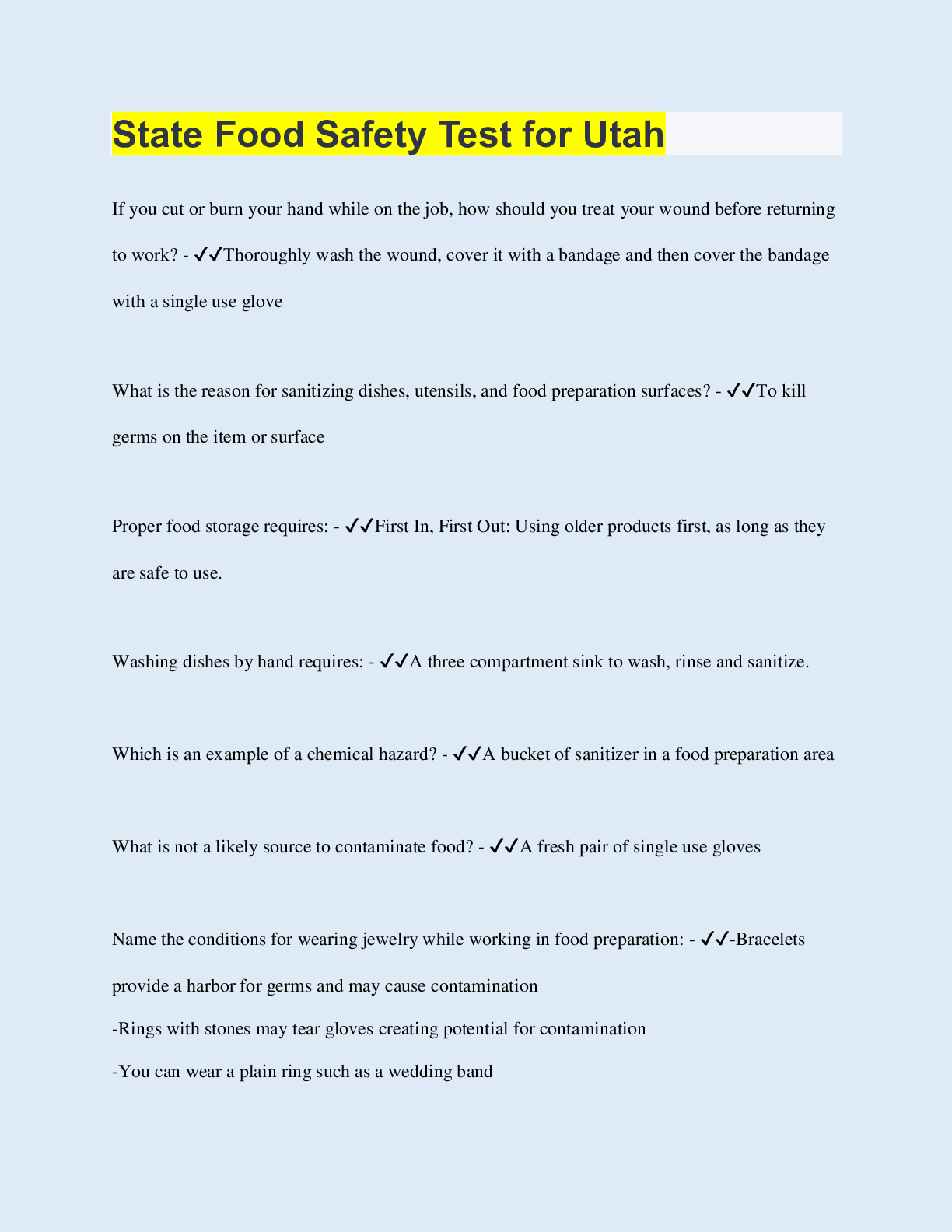Nutrition > EXAM > SCI 228 Week 8 Final Exam Version 1 (100% correct answers) | Download To Score An A (All)
SCI 228 Week 8 Final Exam Version 1 (100% correct answers) | Download To Score An A
Document Content and Description Below
final 1. Question : (TCO 1) Which of the following is TRUE regarding the science of nutrition? Student Answer: As compared to many other scientific disciplines, nutrition is a young science... . Discoveries by the first nutritional scientists established the connection between deficiencies and illness. In developed countries, current research in nutrition focuses on the relationship between diet and chronic diseases. All of these are true. Instructor Explanation: Chapter 1 Points Received: 2 of 2 Comments: 2. Question : (TCO 1) The is most responsible for prompting individuals to seek food. Student Answer: stomach small intestine hypothalamus mouth Instructor Explanation: Chapter 3 Points Received: 2 of 2 Comments: 3. Question : (TCO 1) are strongly accepted principles supported by many hypotheses that have been collectively confirmed through repeated research. Student Answer: Studies Theories Placebos Trials Instructor Explanation: Chapter 1 Points Received: 2 of 2 Comments: 4. Question : (TCO 1) Which of the following nutrients is organic? Student Answer: Minerals Water Protein Both minerals and water Instructor Explanation: Chapter 1 Points Received: 2 of 2 Comments: 5. Question : (TCO 3) Immediately after absorption, what circulatory system carries most of the fat- soluble nutrients? Student Answer: Vascular Mesenteric Lymphatic Enterohepatic Instructor Explanation: Chapter 3 Points Received: 2 of 2 Comments: 6. Question : (TCO 3) What is chyme? Student Answer: Ulcerations of the esophageal lining Healthy bacteria of the small intestine Mixture of partially digested food, water, and gastric juices Substance that allows for the emulsification of dietary lipid Instructor Explanation: Chapter 3 Points Received: 2 of 2 Comments: 7. Question : (TCO 3) An estimated of all chicken eggs in the U.S. are contaminated withSalmonella. Student Answer: one-fifth one-fourth one-third one-half Instructor Explanation: Chapter 18 Points Received: 2 of 2 Comments: 8. Question : (TCO 3) In which of the following environments does Clostridium botulinum flourish? Student Answer: Acidic Alkaline < 40 F > 140 F Instructor Explanation: Chapter 18 Points Received: 2 of 2 Comments: 9. Question : (TCO 3) In the United States, the most common food-borne illnesses result from which of the following bacteria? Student Answer: Giardia lamblia Salmonella Campylobacter jejuni Clostridium botulinum Instructor Explanation: Chapter 18 Points Received: 2 of 2 Comments: 10. Question : (TCO 3) Which human organ system is most affected by toxic levels of mercury? Student Answer: Nervous Renal Cardiovascular Digestive Instructor Explanation: Chapter 18 Grade Details - All Questions 1. Question : (TCO 1) is a highly branched arrangement of glucose molecules found in liver and skeletal muscle cells. Student Answer: Fructose Starch Glycogen Raffinose Instructor Explanation: Chapter 4 2. Question : (TCO 1) The simplest units of carbohydrates are called: Student Answer: fatty acids. amino acids. monosaccharides. calories. Instructor Explanation: Chapter 4 3. Question : (TCO 1) A disaccharide is formed by the chemical bonding of: Student Answer: two monosaccharides. two polysaccharides. one monosaccharide and one polysaccharide. two oligosaccharides. Instructor Explanation: Chapter 4 4. Question : (TCO 2) Glucose is the preferred source of energy for which of the following? Student Answer: Brain cells Red blood cells The central nervous system All of these Instructor Explanation: Chapter 4 5. Question : (TCO 2) Which of the following is associated with the development of ketosis? Student Answer: A diet that contains too much fat A diet that contains insufficient fat A diet that contains too many carbohydrates A diet that contains insufficient carbohydrates Instructor Explanation: Chapter 4 6. Question : (TCO 2) After a meal, which hormone is responsible for moving glucose into the body's cells? Student Answer: Glucagon Estrogen CCK Insulin Instructor Explanation: Chapter 4 7. Question : (TCO 3) Sean is planning to bake a batch of chocolate chip cookies for his girlfriend. Which of the following artificial sweeteners would be the best substitute for the sugar in the recipe? Student Answer: Aspartame Saccharin Sucralose Olestra Instructor Explanation: Chapter 4 8. Question : (TCO 3) Lactose intolerance is due to a(n): Student Answer: deficiency of lactose. deficiency of lactase. deficiency of the GI flora (healthy bacteria). allergy to casein (milk protein). Instructor Explanation: Chapter 4 9. Question : (TCO 3) Individuals with the disease PKU (phenylketonuria) should not consume the artificial sweetener aspartame. Why? Student Answer: People with PKU are highly prone to development of diabetes. People with PKU are allergic to the sweetener. People with PKU experience severe headaches when they consume aspartame. People with PKU cannot metabolize the amino acid phenylalanine. Instructor Explanation: Chapter 4 10. Question : (TCO 4) Up to of the world's population suffers from lactose intolerance. Student Answer: 20% 30% 50% 70% Instructor Explanation: Chapter 4 Grade Details - All Questions 1. Question : (TCO 3) All of the following are major classes of dietary lipids EXCEPT: Student Answer: glycogens. triglycerides. sterols. phospholipids. Instructor Explanation: Chapter 5 2. Question : (TCO 3) A fatty acid that contains a chain of 10 carbons and one double bond is termed a: Student Answer: saturated, medium-chain fatty acid. saturated, long-chain fatty acid. monounsaturated, medium-chain fatty acid. monounsaturated, long-chain fatty acid. Instructor Explanation: Chapter 5 3. Question : (TCO 6) is(are) the key structural component of a cell's membrane. Student Answer: Estrogen Glycerol Phospholipids Triglycerides Instructor Explanation: Chapter 5 4. Question : (TCO 6) Sex hormones and adrenal hormones are substances derived from which class of lipid? Student Answer: Fatty acids Triglycerides Phospholipids Sterols Instructor Explanation: Chapter 5 5. Question : (TCO 6) Which of the following is NOT true of fats? Student Answer: Dietary fats stimulate hunger signals to the brain. Fats add texture and flavor to food. Fats are found in every cell membrane. Adipose tissue stores fat for future energy use. Instructor Explanation: Chapter 5 6. Question : (TCO 5) Which part of an individual amino acid distinguishes it from other amino acids? Student Answer: Side chain Central carbon Amine group Acid group Instructor Explanation: Chapter 6 7. Question : (TCO 5) What dictates the structure of a protein molecule synthesized by the body? Student Answer: The body's need for a protein The DNA inside the nucleus of the cell The number of essential amino acids available The combination of proteins consumed in the diet Instructor Explanation: Chapter 6 8. Question : (TCO 5) Which of the following is NOT a major function of protein in the human body? Student Answer: Maintaining fluid balance Providing energy to the body Growth and maintenance of new tissue Synthesis of hormones Instructor Explanation: Chapter 6 9. Question : (TCO 5) Protein digestion begins in the . Student Answer: mouth stomach small intestine pancreas Instructor Explanation: Chapter 6 10. Question : (TCO 5) Which of the following is a genetic disorder resulting in debilitating protein abnormalities? Student Answer: Cystic fibrosis Mad cow disease Acidosis Kwashiorkor Instructor Explanation: Chapter 6 Grade Details - All Questions 1. Question : (TCO 1) Which of the following is a micronutrient? Student Answer: Carbohydrates Vitamins Lipids Alcohol Instructor Explanation: Chapter 1 2. Question : (TCO 1) An increased risk for obesity, heart disease, and Type 2 diabetes is associated with: Student Answer: diets high in saturated fats. diets low in fiber, fruits, vegetables, and whole grains. Instructor Explanation: Points Received: Comments: diets high in monounsaturated fats and dairy products. both diets high in saturated fats and diets low in fiber, fruits, vegetables, and whole grains. Chapter 1 4 of 4 3. Question : Student Answer: Instructor Explanation: Points Received: Comments: (TCO 1) Which of the following are examples of carbohydrate-rich foods? Butter and corn oil Beef and pork Wheat and lentils Bacon and eggs Chapter 1 4 of 4 4. Question : (TCO 1) For dinner, Bill consumes 255 grams of carbohydrate, 70 grams of protein, and 50 grams of fat. In addition, Bill decides that he wants a glass of wine with his meal. If he drinks one glass of wine containing 8 grams of alcohol, how many total kilocalories does he consume in this meal? Points Received: 4 of 4 Comments: Points Received: 4 of 4 Comments: Points Received: 4 of 4 Comments: Points Received: 4 of 4 Comments: 8. Question : (TCO 2) Your grandmother has recently been diagnosed with type 2 diabetes. Which of the following professionals is most likely to be qualified to offer your grandmother assistance in planning her diabetic diet? Student Answer: Registered Dietitian (RD) PhD in nutrition medical doctor (MD) nutritionist Instructor Explanation: Chapter 1 9. Question : (TCO 2) The standard used to estimate the daily nutrient needs of half of all healthy individuals is: Student Answer: EAR. AI. RDA. UL. Instructor Explanation: Chapter 1 Comments: 10. Question : (TCO 2) The human body is organized into the following structural levels (smallest to largest): Student Answer: molecules: atoms: organs: systems: tissues: cells. atoms: molecules: cells: tissues: organs: systems. organs: tissues: molecules: systems: atoms: organs. atoms: cells: systems: tissues: molecules: organs. Instructor Explanation: Chapter 3 Points Received: 4 of 4 Comments: 11. Question : (TCO 2) Hunger is best described as: Student Answer: a physiological desire to consume food. a psychologyical desire to consume food. eating that is often driven by environmental cues. eating that is often driven by emotional cues. Instructor Explanation: Chapter 2 12. Question : (TCO 2) Which of the following is a limitation of the Exchange System? Student Answer: It can be difficult to learn because the portion sizes differ between exchange lists. Some find the plan restrictive because combination and special occasion foods are prohibited. The diet plan can be monotonous because dietary substitutions are difficult to calculate. Individuals may consume too many kilocalories following this plan because there is no distinction between lean and high-fat meats. Instructor Explanation: Chapter 2 13. Question : (TCO 3) In which of the following food sources would a consumer look for the statement "Live Active Cultures," indicating that the product is a rich source of probiotics? Student Answer: whole-wheat bread fermented yogurt orange juice calcium supplements Instructor Explanation: Chapter 3 14. Question : (TCO 3) Responding to the presence of protein and fat in our meal, cholecystokinin (CCK) signals the gallbladder to release a substance called: Student Answer: lipase. pepsin. chyme. bile. Instructor Explanation: Chapter 3 15. Question : (TCO 3) Which best explains why carbohydrate digestion ceases when food reaches the stomach? Student Answer: Carbohydrate is completely digested in the mouth. Salivary enzymes cannot function in the acid environment of the stomach. Carbohydrate is completely absorbed in the esophagus. Intestinal bacteria are needed for carbohydrate digestion. Instructor Explanation: Chapter 3 16. Question : (TCO 3) Collectively, the nerves of the gastrointestinal tract are referred to as: Student Answer: peptic nerves. hepatic nerves. enteric nerves. gastric nerves. Instructor Explanation: Chapter 3 17. Question : (TCO 3) What is the term that describes the process in which nutrients pass through the wall of the gastrointestinal tract? Student Answer: digestion absorption elimination segmentation Instructor Explanation: Chapter 3 Grade Details - All Questions Student Answer: mitochondrion. ribosome. nucleus. cytoplasm. Instructor Explanation: Chapter 3 Points Received: 4 of 4 Comments: Points Received: 4 of 4 Comments: Points Received: 4 of 4 Comments: Points Received: 4 of 4 Comments: Points Received: 0 of 4 Comments: Points Received: 4 of 4 Comments: Points Received: 4 of 4 Comments: Points Received: 4 of 4 Comments: Points Received: 4 of 4 Comments: Points Received: 0 of 4 Comments: Points Received: 0 of 4 Comments: Points Received: 4 of 4 Comments: Points Received: 0 of 4 Comments: Points Received: 4 of 4 Comments: Grade Details - All Questions Page: 1. Question : (TCO 5) Which of the following fatty acids is generally solid at room temperature? Student Answer: Short-chain Saturated Monounsaturated Polyunsaturated Instructor Explanation: Chapter 5 2. Question : (TCO 5) Why are phospholipids NOT an essential nutrient? Student Answer: Our bodies manufacture phospholipids. Phospholipids are not naturally found in the healthy body. Beneficial GI bacteria produce phospholipids. They provide no useful function in the human body. Instructor Explanation: Chapter 5 3. Question : (TCO 5) As of January 1, 2006, the U.S. Food and Drug Administration will require food manufacturers to list content on the Nutrition Facts Panel of their products. Student Answer: phospholipid sterol essential fatty acid trans fatty acid Instructor Explanation: Chapter 5 4. Question : (TCO 5) Which of the following foods contains invisible fats? Student Answer: Olive oil Zucchini Chocolate cake Butter Instructor Explanation: Chapter 5 5. Question : (TCO 5) Where in the body are the majority of triglycerides stored for future energy needs? Student Answer: Lipoproteins Beta cells of the pancreas Liver Adipose tissue Instructor Explanation: Chapter 5 6. Question : (TCO 5) is(are) the key structural component of a cell's membrane. Student Answer: Estrogen Glycerol Phospholipids Triglycerides Instructor Explanation: Chapter 5 Points Received: 4 of 4 Comments: 7. Question : (TCO 5) Yesterday, Shannon consumed 250 grams of carbohydrates, 75 grams of protein, and 60 grams of fat. What percentage of calories of her day's intake came from fat? Student Answer: 13% 15% 29% 35% Instructor Explanation: Chapter 5 Points Received: 0 of 4 Comments: 8. Question : (TCO 5) Transport vehicles for most lipids are called: Student Answer: lipoproteins. peptides. monoglycerides. glycerols. Instructor Explanation: Points Received: Comments: Chapter 5 4 of 4 9. Question : Student Answer: Instructor Explanation: Points Received: Comments: (TCO 6) Which of the following supplements would you recommend a vegan add to his or her diet? Protein Fiber Vitamin B12 Vitamin C Chapter 6 4 of 4 10. Question : Student Answer: (TCO 6) Protein digestion begins in the . mouth stomach small intestine Instructor Explanation: Points Received: Comments: pancreas Chapter 6 4 of 4 11. Question : Student Answer: Instructor Explanation: Points Received: Comments: (TCO 6) The process through which mRNA copies genetic information from DNA and carries it to the ribosome is called: translation. deamination. denaturation. transcription. Chapter 6 0 of 4 12. Question : Student Answer: (TCO 6) Which of the following is associated with marasmus? Distended abdomen "Skin and bones" appearance Instructor Explanation: Points Received: Comments: Enlarged, fatty liver All of these Chapter 6 4 of 4 13. Question : Student Answer: Instructor Explanation: Points Received: Comments: (TCO 6) Which of the following statements is FALSE? The healthy body's primary energy source is carbohydrates and fat. The body stores excess protein primarily for energy reserves. To utilize protein for energy, the amine group is removed. Eating sufficient carbohydrates and fat will spare body protein. Chapter 6 0 of 4 14. Question : Student Answer: (TCO 6) Oligopeptides are a string of amino acids. one to two Instructor Explanation: Points Received: Comments: four to nine 10-15 more than 25 Chapter 6 4 of 4 15. Question : Student Answer: Instructor Explanation: Points Received: Comments: (TCO 6) What element makes protein different from carbohydrates and fat? Carbon Hydrogen Oxygen Nitrogen Chapter 6 4 of 4 16. Question : (TCO 6) The part of the protein molecule that carries nitrogen is the: Student Answer: acid group. amine group. side chain. hydrogen group. Instructor Explanation: Chapter 6 Grade Details - All Questions 1. Question : (TCO 3) Where does our body obtain the majority of its antioxidants? Student Answer: Via sunlight From the by-products of healthy metabolism From the diet Gastrointestinal microflora Instructor Explanation: Chapter 8 2. Question : (TCO 3) What is the antioxidant enzyme system that functions by removing hydrogen peroxide from the body by converting it into water and oxygen? Student Answer: Superoxide dismutase Catalase Glutathione peroxidase Microsomal enzyme-oxidizing system Instructor Explanation: Chapter 8 3. Question : (TCO 7) Who is at risk for a Vitamin E deficiency? Student Answer: Premature infants Postmenopausal women Male athletes The elderly Instructor Explanation: Chapter 8 4. Question : (TCO 7) The deficiency disease associated with Vitamin C is: Student Answer: scurvy. erythrocyte hemolysis. night blindness. Keshan disease. Instructor Explanation: Chapter 8 5. Question : (TCO 7) Which of the following increases the RDA for Vitamin C? Student Answer: Smoking cigarettes Drinking alcohol Being a vegan Taking supplements of Vitamin C Instructor Explanation: Chapter 8 6. Question : (TCO 8) Which of the following is NOT considered an essential nutrient? Student Answer: Vitamin A Beta-carotene Vitamin C Vitamin E Instructor Explanation: Chapter 8 7. Question : (TCO 8) At what age does bone resorption generally begin to occur more rapidly than bone formation? Student Answer: 10 20 40 60 Instructor Explanation: Chapter 9 8. Question : (TCO 8) Vitamin D toxicity is associated with: Student Answer: sunburns. suntan lotions. seafood. supplements. Instructor Explanation: Chapter 9 9. Question : (TCO 9) Folate deficiency during pregnancy is associated with: Student Answer: Down's syndrome. gestational diabetes. neural tube defects. pellagra. Instructor Explanation: Chapter 10 Points Received: 2 of 2 Comments: Points Received: 2 of 2 Comments: Grade Details - All Questions 1. Question : (TCO 1) The maximal heart rate for a 30-year-old individual would be: Student Answer: 220 beats per minute (bpm). 150 beats per minute (bpm). 190 beats per minute (bpm). Instructor Explanation: Points Received: Comments: 100 beats per minute (bpm). Chapter 11 2 of 2 2. Question : Student Answer: Instructor Explanation: Points Received: Comments: (TCO 2) Which of the following describes the effect that severe dieting has on basal metabolic rate? Basal metabolic rate is decreased. Basal metabolic rate is increased. Basal metabolic rate is unchanged. The effect on basal metabolic rate varies. Chapter 11 2 of 2 3. Question : Student Answer: (TCO 3) The recommended intake of cholesterol is less than mg per day. 1,000 500 Points Received: Comments: 2 of 2 Points Received: Comments: 2 of 2 Student Answer: A psychiatric condition that requires a physician's diagnosis Any condition in which one's eating behavior changes more Student Answer: Schizophrenia Depression Psychosis Anorexia nervosa Instructor Explanation: Chapter 15 Points Received: 2 of 2 Comments: 8. Question : (TCO 8) Which of the following BEST describes an episode of binge eating? Student Answer: Eating a large amount of food in a short period of time Eating without regard to hunger Consuming food beyond feeling satiated (i.e., until overfull) Consuming any food outside the parameters of a self-imposed restrictive diet Instructor Explanation: Chapter 15 Points Received: 2 of 2 Comments: 1. (TCO 4) A low-birth-weight infant will weigh: (Points : 2) less than 5.5 pounds. less than 6.0 pounds. less than 6.5 pounds. less than 7.0 pounds. 2. (TCO 4) In which trimester of pregnancy is the fetus the most vulnerable to teratogens? (Points : 2) First Second Third Fourth 3. (TCO 5) Which of the following fatty acids is critical to fetal brain and eye development? (Points : 2) Stearic acid Oleic acid Docosahexaenoic acid (DHA) Palmitic acid 4. (TCO 6) Which of the following enhances the absorption of iron? (Points : 2) Caffeine Bran Vitamin C Oxalates 5. (TCO 7) The hormone that suppresses milk production during pregnancy is: (Points : 2) estrogen. prolactin. progesterone. both estrogen and progesterone. 6. (TCO 8) Baby Billy is currently five months old. Since birth, Billy's weight and height have been in the 95th percentile on the growth charts. What does this tell you about Billy's growth and development? (Points : 2) Billy is underweight and is not growing well. Billy is overweight and is consuming too many calories. Billy is growing consistently; he may grow to be a larger, but healthy adult. Billy is growing normally; he may grow to be a smaller, but healthy adult. 7. (TCO 9) Which of the following foods would be the best source of dietary calcium for a young toddler? (Points : 2) Spinach Skim milk Whole milk All of these are equally good choices. 8. (TCO 10) Which of the following is FALSE regarding the RDA for carbohydrates? (Points : 2) This recommendation stays the same as we age. This amount ensures adequate glucose to the brain. Most healthy individuals require more than this recommendation. This amount is difficult for elderly individuals to consume in their diets. 9. (TCO 10) Meals-on-Wheels is a nonprofit food program that: (Points : 2) offers canned goods and other nonperishable food items to seniors free of charge. provides coupons to low-income seniors to purchase food at local farmers' markets. delivers fully prepared meals to homebound ill and elderly clients. provides coupons to low-income seniors to purchase food at local grocery stores. 10. (TCO 10) How much fat is recommended for a preschooler? (Points : 2) 10-20% of total energy 15-25% of total energy 25-35% of total energy 40-50% of total energy Week 1: Introduction to Nutrition, Health, and Wellness, the Digestive System, and Food Safety - Lecture Print This Page Introduction to Nutrition, Health, and Wellness, the Digestive System, and Food Safety Introduction | Introduction to Nutrition | Digestion: The Whole Story | Food Safety and Technology Welcome to Week 1 of class. Each week, there will be a series of short lectures covering important aspects of the text. This week is not just for introductions, but it is also a time to focus on the science of nutrition, digestion, and food safety. Let's get started! What is nutrition? This is a question that I am sure has been asked for hundreds of years. In a nutshell, the study of food and how it impacts our bodies is really the definition of nutrition. Although it may not seem like it, nutrition is a relatively new science. Food, however, has played a defining role in our lives for centuries. Why is nutrition so important? Did you know that the foods you eat supply your body with the fuel it needs to function properly? In addition, proper nutrition can also help to improve our health, prevent deficiency and other types of diseases, help to maintain a desirable weight, and support energy and vitality. Now that we know nutrition's purpose, it probably makes sense to discuss a few terms that will help each of you in deciding how much of each food that you need to stay healthy. 1. Dietary Reference Intakes (DRI) - The DRIs are dietary guidelines for healthy people, and they identify the amount of a nutrient needed to prevent deficiencies. They also take into account chronic disease and what we can do about reducing it through food. The DRIs are made up of four other values, and they include the following components. o Estimated Average Requirement (EAR) - Includes the nutrient amount that 50% of healthy individuals require for health. o Recommended Daily Allowance (RDA) - Includes the nutrient amounts that people need per day; supports 97-98% of a healthy population. o Adequate Intake (AI) - An estimation of the nutrient intake on a daily basis; determined by estimating nutrient intake of a group of people. o Tolerable Upper Intake Level (UL) -The highest amount of nutrients that one can take in without any risk or adverse events. 2. Estimated Energy Requirement (EER) - Includes the nutrients that one needs to support energy balance in healthy adults. Note that this value can be individualized based on a person's energy intake, energy expenditure, age, gender, weight, and height. 3. Acceptable Macronutrient Distribution Ranges (AMDRs) - Includes the amount of nutrients that one may take in that provides adequate intakes of essential nutrients and is also associated with a reduced risk of chronic disease. Please note that a healthful diet has four pillars or characteristics. They include: adequacy, variety, balance, and moderation. The human body is an amazing machine. It has the ability to extract nutrients from foods and utilize them for various aspects of our bodies, including developing red blood cells, helping muscles grow, and even supplying the appropriate amount of energy for us to live and go about our daily lives. Think of your body as a food processor as it extracts nutrients from the foods that we eat and takes them on a digestive journey, which includes four main processes. • Mechanical digestion • Chemical digestion • Propulsion • Absorption Think of a ham and cheese sandwich and all of the different processes that happen while it is traveling within the body. First and foremost, the mouth will play a major role in the digestive process, as it prepares the food by breaking it down through the use of saliva, enzymes, and chewing. Once the food is ready to go onto the next process, the food is then taken through the esophagus, which acts as a conduit and propels food to the stomach. Food is further digested and mixed in the stomach, so that it is liquefied and ready for the digestive processes of the small intestine. This is the place where most of the digestive process takes place: the small intestine. Fingerlike projections known as villi enhance the small intestine's surface area and allow for efficient digestion and absorption. Digestion is completed when nutrients are reduced to substances that can be absorbed and nutrients are released from food. Although most nutrients are absorbed in the small intestine, some substances are absorbed from the large intestine. After the last bit of absorption takes place in the large intestine, substances in food that cannot be absorbed are eliminated from the body as waste. What does food safety mean to you? Does it have to do with illness, unsafe handling practices, or both? Did you know that each year, food-related illnesses cause two things? • 325,000 hospital stays • More than 5,000 deaths Food illnesses/reactions can be broken down into several categories, and they include: • Foodborne illness/food poisoning - Leading cause of illness affecting more than 76 million people each year. Foodborne illness results from poor handling of food. An example of a foodborne illness would be food contaminated with Salmonella, usually referred to as food intoxication, food infections, or just plain old food poisoning. o Food infection - After food is consumed and bacteria or other microbes are present, they can attack the body and a food infection can occur. o Food intoxication - Toxins that are already in the food are ingested and food intoxication can occur; bacteria produced by exotoxins cause food intoxication, and the scary thing is that the bacteria may not even still be in the food. • Food allergies - An exaggerated immune response to a food protein. There are eight major food allergies. o Milk o Eggs o Fish (e.g., bass, flounder, cod) o Crustacean shellfish (e.g. crab, lobster, shrimp) o Tree nuts (e.g., almonds, walnuts, pecans) o Peanuts o Wheat o Soybeans How can foodborne illness be prevented? According to the Centers for Disease Control, although there is a host of things that one can do, there are four specific behaviors that can prevent the spread of foodborne illness. 1. Keep surfaces and hands clean. 2. Keep food chilled and refrigerate promptly. 3. Maintain a proper temperature and use adequate heat to cook foods. 4. Prevent cross contamination by separating food. Week 2: Introduction to Carbohydrates and Physical Activity - Lecture Print This Page Introduction to Carbohydrates and Physical Activity Introduction to Carbohydrates | Digesting Carbohydrates | Carbohydrates in the Diet | The Role of Physical Exercise and Health The literal translation of the term carbohydrates means carbon and water, and it is these substances that are considered the major source of energy for people throughout the world. Besides being the preferred energy source for the body, carbohydrates prevent protein from being used for energy, plus they help the body use fat efficiently. The carbohydrate family consists of three types of substances. 1. Simple Sugars - Includes mono and disaccharides (one to two carbon chains). 2. Complex Carbohydrates (often referred to as starch, glycogen, or polysaccharides...many carbon changes linked together). 3. Total Fiber - Includes soluble and insoluble fiber. Simple sugars are carbohydrates, often referred to as monosaccharides, and they consist of only one carbon chain in the form of glucose, fructose, or galactose. Disaccharides, on the other hand, contain two monosaccharides and are also considered to be simple sugars that consist of two molecules of monosaccharide bonded together. The corresponding sugars are lactose, sucrose, or maltose. The third type of sugar, polysaccharides, or complex carbohydrates, are a form of carbohydrates found mostly in starchy vegetables, grains, dried beans, and many types of grains. The only sugar that the body can use to form energy is glucose. That is not a problem because all forms of sugars are broken down into one of the simple sugars, fructose, galactose, or glucose, and those are then readily converted to glucose. When one consumes a diet rich in carbohydrates (plus other components as well), the hormone known as insulin is released. It is this hormone that helps draw the sugar from your food and from your blood into your cells to be used for energy. When one overeats and the body has more glucose than it needs for energy formation, it is converted to glycogen, the storage form of glucose (found in the liver and muscle) and deposited as fat. When the body does not have enough energy to support basic bodily functions and/or when your blood sugar is low, glucagon, a hormone, is released. Upon its release, glycogen is also released. Now that the body has energy and your blood sugar has risen, insulin will then be released so that this energy can be utilized by the cell. Learning Tools Carbohydrates are very important molecules to our cells. Please view this link on carbohydrates to understand the chemistry a little more. Please have your speakers turned on when viewing this tutorial. Carbohydrates | View Transcript Learning Tools Sometimes, sugars do not enter or diffuse through the cell membranes correctly. (Remember the diffusion animation from Lecture 1?) View these links to understand diabetes Food sources of carbohydrates can be found in many foods, including fruits and vegetables (simple sugars), milk and dairy (disaccharides), and breads and cereals (complex). Most of the sugar that enters our diet is in the form that has been added to a food, primarily, simple sugars. Although used primarily for their taste, simple sugars improve the consistency and cooking properties of many food products. Consequently, Americans consume 124 grams of added sugar all day (about three teaspoons). Sugar consumption has increased 23% in the past 30 years. Simple sugars, especially the ones in which sugar has been added to the food, are typically not the best choice with regard to nutrients. Simple sugars are among the few foods that provide only calories, and these calories have been blamed for the obesity epidemic that will be discussing at length during Week 6. When it comes to complex carbohydrates, one should try to use whole grain products, as they provide a source of fiber. Of course, there are complex carbohydrates in other plant foods such as corn and potatoes, and even though those foods are healthy for you, it is always best to choose whole grains because they provide more fiber. Fiber is considered a complex carbohydrate that cannot be fully digested. Unfortunately, the total fiber intake by U.S. adults is well below the amount recommended, which falls somewhere between 25-38 grams per day. Fiber can be classified according to its type and its physical properties. Let's take a look. 1. Functional Fiber - Non-digestible carbohydrates like psyllium and pectin that have beneficial effects on health, including supporting healthy blood glucose levels. Functional fibers supply soluble fiber, which are fibers that can dissolve in water. 2. Dietary Fiber - Naturally occurring and found in plants and woody plant cell walls, insoluble fiber is found in dietary fiber and these types of fiber include wheat bran; dietary fiber is associated with supporting digestive health, alleviating constipation, and reducing the risk of diverticulitis. 3. Total Fiber - Includes both dietary and functional fiber. When it comes to physical activity, people usually relegate it to athletes or those who have a lot of time on their hands. Yet studies show that exercise has a great effect on the typical person, including reducing the risk of disease, increasing a sense of well being, and helping to relieve stress. Your diet can make a strong contribution to your level of fitness. That's because good diets contribute to health and it is easier to become physically fit if you are in good health. Interestingly enough, combined with a moderate decrease in calories of around 200 per day, exercise helps people lose weight, build muscle, and become physically fit. Many of the benefits of physical activity are related to the physical fitness that it can produce. Physical fitness is not defined by bulging muscles, thin waistlines, or an amount of physical activity. According to the American College of Sports Medicine, physical fitness is a state of health measured by the components of a sound fitness program. A sound fitness program includes five areas, as seen below. 1. Resistance training 2. Flexibility 3. Cardiovascular training 4. Endurance 5. Body-fat The best type of diet for physical fitness is the same one that is recommended for people in general. It includes adequacy, variety, balance, and moderation. Healthy diets promote physical fitness because they facilitate maintenance of normal weight, reduce plaque buildup in arteries, and supply adequate amounts of essential nutrients. Week 3: Introduction to Lipids and Protein - Lecture Print This Page Introduction to Lipids and Protein Introduction to Lipids | Digesting Lipids | Lipids in the Diet | Introduction to Proteins | Digesting Proteins | Proteins in the Diet Did you know that lipids, otherwise known as fats, are necessary for us to live? The important thing to remember for Americans is that there are healthy and good fats, versus unhealthy and bad fats. Let's take a look at the different types of fats and their roles in the body. Lipids are one of the six essential nutrients for life, but they differ from carbohydrates and proteins because they are not soluble in water. Since lipids/fats cannot dissolve in water, they are digested differently than the other macronutrients. Lipids have many uses in the body, including being a source of energy, supporting fat-soluble vitamin absorption, increasing flavor, providing us with a sensation of being full, and serving as a component of cell membranes and hormones. There are three types of lipids. 1. Triglycerides - Main source of fat that is found in food and the storage form found in the body. 2. Phospholipids - Component of cellular membranes. 3. Sterols - These substances serve as precursors for hormones and Vitamin D. As stated above, lipids/fats are not soluble in water, so when digestion takes place, there are various steps that differ from carbohydrates and proteins. Digestion of lipids includes various steps. • When food is eaten, an enzyme, known as lingual lipase, is produced and the digestion of lipids begins in the mouth. • Most fat arrives at the stomach, intact, and this is where it is mixed and broken down into droplets. Only a small amount of gastric lipase is available in the stomach, and not much fat digestion occurs here. • Once the food, now known as chyme, enters the small intestine, bile is released from the gallbladder. • The role of bile is to prepare fat for the enzyme lipase. This enzyme breaks the traditional triglyceride (the type of fat found in most foods) into two components, fatty acids and glycerol. • Free fatty acids are then transported to the cells of the small intestine for absorption. Learning Tools Fats are needed in our diets, though we average Americans tend to eat too much fat. View these links and see how fats are worked on by our bodies during the digestion process. By viewing these items, this week's lab will be more understandable. Emulsification of Fat | View Transcript Overview of Lipids | View Transcript When it comes to fats, Americans generally consume more than the recommended levels. One's consumption should be between 20-35% of their total energy per day. This recommendation is based on evidence that higher intakes of fat increase the risk of obesity and other things, including heart disease and cancer. We should minimize our intake of the bad fats, which include saturated and trans fats. By minimizing consumption of these types of fat, your risk of heart disease and cancer will be significantly lower. Learning Tools Some people have genetic factors that predispose them to developing heart problems. In such cases, lifestyle adjustments are required. Click on the link below from the American Heart Association. Go to "grocery list online" and then to "find heart-healthy foods." Explore this site and create your own healthy shopping list! Healthy Shopping List | View Transcript http://www.americanheart.org/presenter.jhtml?identifier=1200000 As one of the three macronutrients (carbohydrates, lipids, and proteins), protein is an integral part of our diet and performs several functions. 1. Supporting the development of muscles, connective tissue, organs, and hemoglobin. 2. Acting as the foundation for the creation of chemical substances in our bodies like enzymes, hormones, and other biological elements. 3. Tissue maintenance and repair. 4. Although not one of its major roles, protein can serve as an energy source. Proteins are made up of 20 different amino acids, which are considered to be the foundation for the actual protein molecule. There are 11 essential amino acids, and they are considered essential because they cannot be produced in the body. There are nine non-essential amino acids, but unlike the essential ones, non-essential amino acids can be constructed from compounds in the body. Once the amino acids form protein chains, they are considered to be complete or incomplete. Complete proteins are food sources of high-quality protein which means that they contain all of the essential amino acids. Incomplete proteins are deficient in one or more of the essential amino acids. The interesting thing is that incomplete proteins can be combined with other incomplete proteins to produce complete protein. Dishes like beans and rice, and macaroni and cheese, are examples of incomplete or complementary proteins that, when combined together, form a complete protein. Learning Tools Our bodies also need proteins. Their amino acids are the building blocks for many molecules. Viewing this link will aid the student in this week's lab and aid in protein comprehension. Overview of Protein Synthesis | View Transcript Digestion of proteins includes various steps. • In the mouth, chewing crushes and softens protein-rich foods and mixes them with saliva. • Stomach acids work to denature protein strands and to activate the stomach's protein-digesting enzyme. It is hydrochloric acid that helps to convert the inactive enzyme, pepsinogen, to its active form of pepsin. Pepsin breaks protein strands down into smaller fragments. • While the protein emerges from the stomach, trypsin (another protein-digestive enzyme) splits protein into molecules in the small intestine. • The large intestine helps to excrete residue out of the body, because normally, almost all food protein is digested and absorbed. The average intake of protein in the United States exceeds the RDA for men and women and more than 50% of the protein consumed comes from your typical animal sources. When it comes to diets that are protein rich, the trend can be quite dangerous and potentially lead to calcium loss (osteoporosis), kidney disease, and/or high cholesterol (which can lead to heart disease). Diets that contain inadequate protein can be quite detrimental to one's health, and protein deficiency can lead to two conditions. • Kwashiorkor: protein energy malnutrition that generally develops in children and infants. Those with this disease generally have a difficult time using body proteins for energy, so these people typically suffer from ailments ranging from abnormal metabolic adaptations to starvation. • Marasmus: Although more easily treated than Kwashiorkor, it is considered a condition of severe body wasting due to deficiencies in both protein and calories. Learning Tools Proteins are very important molecules. These two links will illustrate their importance in terms of structure and functions. The lab for this week will utilize information gleaned from these links. Week 4: Introduction to Hydration, Fluids, and Electrolyte Disorders - Lecture Print This Page Introduction to Hydration, Fluids, and Electrolyte Disorders Chemistry of Water | Electrolytes | Terms to Keep in Mind | Why is this so Important? Have you ever thought of how amazing water truly is? It is so special, that you cannot live without it. Even its molecular makeup is amazing, and because water is so complex, that it allows so many things to happen to it and around it, and those other compounds cannot even compare to it! Due to its molecular structure (2 hydrogen atoms and 1 oxygen atom-H20), water is able to bond with any charged atom, and because the molecular structure is so simple and unique, water is actively attracted to plenty of positively and negatively charged molecules. Electrolytes are charged (positive-cation or negative-anion) particles in the body that help to maintain the normal balance of homeostasis (balance within our body) of our cells, and therefore, our body. Electrolytes or other types of molecules similar to these ones can easily be attracted to either part of the water molecule because they are so versatile, (remember, water molecules include two positively charged hydrogen atoms and one negatively charged oxygen atom, due to its electrons), and because the water molecule is so versatile and can develop a strong cohesive force with its unique makeup and types of electrical charges. This fact means that water adheres to particles, substances, or electrolytes, and is transported to and away from the cell quite easily. Due to this ability, water is able to be used quite readily by the cells and our bodies for their crucial functions (see table below). Table 7.2 Functions, Recommended Intakes, and Toxicity and Deficiency Symptoms of Primary Electrolytes Nutrient Primary Functions Recommended Intake Toxicity Symptoms Deficiency Symptoms Sodium Major positively charged electrolyte in extracellular 1.5g/day1 Water retention High blood Muscle cramps Loss of Nutrient Primary Functions Recommended Intake Toxicity Symptoms Deficiency Symptoms fluid Maintains proper acid- base balance Assists with transmission of nerve signals Aids muscle contraction Assists in the absorption of glucose and other nutrients pressure May increase loss of calcium in urine appetite Dizziness Fatigue Nausea Vomiting Mental confusion Potassium Major positively charged electrolyte in intracellular fluid Regulates contraction of muscles Regulates transmission of nerve impulse Assists in maintaining healthy blood pressure levels 4.7g/day1 Muscle weakness Vomiting Irregular heartbeat Muscle weakness Muscle paralysis Mental confusion Choride Assists with maintaining fluid 2.3g/day1 Vomiting Dangerous changes in pH Nutrient Primary Functions Recommended Intake Toxicity Symptoms Deficiency Symptoms balance Aids in preparing food for digestion (as HCI) Helps kill bacteria Assists in the transmission of nerve impulses Irregular heartbeat Phosphorus Major negatively charged electrolyte in intracellular fluid Maintains proper fluid balance Plays critical role in bone formation Component of AIP, which provides energy for our bodies Helps regulate biochemical reactions Major part of genetic materials 700mg/day2 Muscle spasms Convulsions Low blood- calcium levels Muscle weakness Bone pain Dizziness Nutrient Primary Functions Recommended Intake Toxicity Symptoms Deficiency Symptoms (DNA, RNA) A component in cell membranes, LDL Due to its unique bonding abilities (water molecules are cohesive and cling together with both hydrogen bonding and polarity), water molecules exhibit an amazing set of properties, one of which is its ability to flow freely. This ability, along with its cohesive property, allows water to be dissolved and suspend molecules, making it an excellent transport system for nutrients. Its ability as a solvent (ability to be able to dissolve nutrients, particles, or be dissolved) is also important because it can help facilitate reactions both in and outside of the cell. Remember that cells have particles or solutes within them, and the area or fluid around the cell is known as the solution. There are also particles within the solution as well. There are three main ways that move things in and out of cells. 1. Diffusion-Consists of a random movement of molecules from a place of higher concentration of solutes to an area of lower concentration, until equal distribution occurs between both areas. Think of opening a perfume bottle, and how after a while, the entire room smells like the perfume. This example is often considered a form of passive transport. 2. Osmosis-Occurs within a semi-permeable membrane across an area of higher concentration to lower concentration. An example of osmosis would be when a protein pushes an ion against the concentration gradient of the cell, and it takes energy to make this move and allow the substance to enter the cell. Osmosis can often be referred to as active transport. 3. Facilitated transport (also referred to as facilitated diffusion)-Molecules are transported across the plasma membrane from the side of higher concentration to the side of lower concentration, and oftentimes, this can be passive or active (where a molecule is moving against the gradient from lower to higher). In this type of transport, a protein carrier and the use of energy (breakdown of ATP) must be used. Electrolytes: Electrolytes, otherwise known as salts, are substances that can carry a positive or negative charge. They conduct electricity and can be found in the body. Here are five examples. • Chloride • Calcium • Magnesium • Potassium • Sodium Homeostasis: The body's internal ability to maintain balance, if you will. A relative constancy that exists in the body so that all systems can work to the best of their abilities. An example of homeostasis would be when your body gets overheated and you begin to sweat. This is homeostasis at its finest, and involves the endocrine, respiratory, cardiac, and urinary systems. Polarity: Separation of charge leading to a dipole. Solubility: The ability of a substance to dissolve. Solute: A substance dissolved in a solution. Examples of solutes would be salt dissolved in water where salt is the solute and water is the solvent. Solvent: A substance with the ability to dissolve something. Solution: A mixture of materials such as salt and water. There are several types of solutions. Three of them are listed below. • Isotonic Solutions - A solution with the same salt/electrolyte concentration; no movement in or out of the cell or movement remains constant. • Hypertonic Solutions - Comprised of a solution with more salt than what is found in normal cells. Because the solution has a higher salt content than what is found in normal cells, water flows toward the salt, and the cell has the ability to swell and burst. • Hypotonic Solution - Comprised of a solution with less salt than what is found in normal cells. Because the solution has a lower salt content than what is found in normal cells, water flows away from the salt to the area that has greater solutes. When this happens, water flows outside of the cell (toward greater concentration of solutes) and the cell has the ability to shrink. The reason why these concepts have been brought up is due to the fact that our cells and our bloodstream can often be referred to as solutions. Depending on the particles in this solution, the cell and the solution (fluid or blood) will have different properties and will flow across the cell membrane in a variety of fashions. As you know, things like proteins, hormones, enzymes, electrolytes, and other particles must enter the cell, and there are a variety of methods for this action to take place. Week 5: Introduction to Bone Health and Vitamins/Minerals - Lecture Print This Page Introduction to Bone Health and Vitamins and Minerals Bone Introduction | Bone-Supporting Nutrients | Vitamins and Minerals | Dietary Supplement Overview Bones are a crucial element in the body as they provide shape and support and actually protect the body by shielding the brain, spinal cord, lungs, and heart. And if we didn't have bones as points of attachment and leverage for our muscles, we would not be able to move. Our bones also serve some other purposes that may not be as well known, like playing a role in blood formation, supporting electrolyte function, and maintaining the acid/base balance in the body. Two of the most crucial things the skeletal system does are provide structure and serve as a bank for minerals like calcium, phosphorus, magnesium, sodium, and carbonate. Bone is constantly trying to maintain equilibrium between mature bone cells (osteocytes), bone-building cells (osteoblasts), and bone destroying cells (osteoclasts). A balance in calcium generally reflects an environment where the process of gaining and losing bone is constant. Ensuring that your diet is adequate in calcium can help maintain calcium levels in the blood so that a negative calcium balance and excessive bone loss (bone resorption) do not occur. We all agree that bone health should start at an early age, and of course diet and exercise play a vital role. Several minerals are essential to bone health, and as the most abundant mineral in the body, calcium is the primary ingredient in the bones and teeth. Bones and teeth account for about 99% of the total body stores of calcium. Depending on one's age, the RDA for calcium runs anywhere between 500mg and 1200mg per day. Calcium can be found in dairy products, but for those who choose not to consume dairy or may be lactose intolerant, calcium can be found in spinach, salmon, almonds, and certain fruits and vegetables. As one of the most important minerals related to bone health, it is relevant to recognize that certain substances can promote calcium loss. Substances like caffeine, excess protein, high levels of sodium, and even excess amounts of phosphorus or Vitamin A can play a negative role in the diet, so it is important to educate yourself and make wise dietary choices. Another crucial mineral to bone health is magnesium. In fact, 60% of the human body's magnesium stores are found in the bones. Magnesium and calcium work together to promote bone health. Magnesium helps the transportation of calcium out of the gastrointestinal tract and into the bone, and it also helps to control hundreds of enzymatic reactions in cells that influence bone density. Magnesium is also responsible for protein formation. Magnesium needs vary depending on age, but for adults the dosage is 300mg per day. Food sources include fish, fruits, and dairy products. Phosphorus is another essential mineral for bone health. Did you know that 85% of the phosphorus in our bodies is found in our bones? The interesting thing is that calcium alone is not sufficient to build strong bones; rather, building strong bones requires a composition of calcium and phosphorus known as hydroxyapatite. Food sources of phosphorus include dairy, meats and beans, and legumes, and one should consume about 700mg or phosphorus per day. Learning Tools Bone Building Vitamins and minerals are substances that perform specific functions in the body. They are considered part of the six essential elements for life, and because of this we are required to consume them or serious deficiency diseases can develop. Vitamins are organic substances, and although they do not provide energy like carbohydrates, fats, or proteins, they do play critical roles as coenzymes (help to activate specific enzymes) in the conversion of macronutrients into energy, as well as provide tissue structure support. Vitamins come in the following two forms. 1. Water soluble - Includes the B vitamins and Vitamin C; these vitamins are soluble in water, so it is necessary to consume them on a regular basis as they cannot be stored in sufficient amounts. 2. Fat soluble - Vitamins A, D, E, and K are considered fat soluble because they dissolve in fat, and they can be stored in body fat, the liver, and other parts of the body. Minerals are inorganic substances that perform specific body functions and must be supplied by the diet. Minerals are considered essential because they play many roles, including that of a cofactor, which helps enhance the activity of certain proteins, as well as playing a role in both structural and metabolic aspects of the body. Minerals can also be divided into the following two groups. 1. Macrominerals - Required in the body in high quantities and include calcium, chloride, magnesium, phosphorus, potassium, sodium, and sulfur. 2. Microminerals (or trace) - Required in smaller quantities in the body and include boron, chromium, fluoride, iron, silicon, selenium, zinc, and a host of others. Did you know that only 9% of all American adults consume enough healthy foods to reach even the minimum recommended daily intake to assure proper health? Enter dietary supplements! In the early 90s, the Dietary Supplement Health and Education Act was created, and this act basically defined supplements as "substances that are intended to supplement the diet, and can take the form of a vitamin, mineral, amino acid, herb, botanical, a concentrate, such as a meal replacement, energy bar or a metabolite, constituent, or extract" (DSHEA Act, 1994). The substance must be ingested in a pill, capsule, tablet, or liquid form, and it should not be the sole source of nutrients but rather a supplement to the diet. Along with the many myths associated with dietary supplements, the one that has to do with regulation is the most crucial. Although most people do not think supplements are regulated, they are regulated just like food because they are permitted to enter the market. It is important to note that the FDA does not preapprove dietary supplements before they reach the shelves, and technically, the FDA can only go after dietary supplement manufacturers after a complaint or an adverse event happens. Unfortunately, there are many fraudulent companies out there, and it is a small percentage of manufacturers that do not follow good manufacturing practices or that sell unsafe supplements that often defines the supplement industry. Of course, each person has to decide what makes the most sense when it comes to supplementing his or her diet, and it is essential that any decision associated with dietary supplements be discussed with your healthcare practitioner. Week 6: Introduction to a Healthy Body Weight and Disordered Weight Behaviors - Lecture Print This Page Introduction to a Healthy Body Weight and Disordered Weight Behaviors Achieving a Healthy Body Weight | Methods for Measuring Body Fat Composition | Calories In & Calories Out | Disordered Eating | Anorexia Nervosa | Bulimic Nervosa | Binge Eating Disorder | Pica The goal of any dietary regimen should be to strive for a healthy body weight, and interestingly enough, it is a combination of culture and science that defines the appropriateness of body size. Did you know that in the 30s women were a lot heavier than they are now and that was considered normal, whereas in the 1960s extreme thinness was in? Do not forget that science plays an integral role in weight standards, and although culture is relevant, examining one's weight from a scientific perspective is valuable and provides clues into the world of weight management. There are several methods used for determining one's health status with regard to their weight, but the most common one is known as BMI, or body mass index. Although a valuable tool for looking at trends, BMI does not take into account how much fat you have, the amount of muscle you have, your age, your sex, your race, or how your fat is distributed. Additional methods for assessing body fat include the following things. • Waist-to-hip ratio • Skinfold thickness • Bioelectrical impedance • Underwater weighing • Dual-energy X-ray absorptiometry (DEXA) • Whole air displacement (Bod Pod) Americans are gaining weight faster than they are losing it, and the incidence of obesity in the U.S. is on the rise. Why are people gaining weight, and how can they prevent it? For most people, excess body fat accumulates over time, and without even thinking about it one eats more calories/energy than one burns; with this equation, a person will gain weight. Fat is typically put on slowly, and that's the best way to take it off. Some of the things you can do to lose weight include the following things. • Listen to your internal hunger cues. • Drink ample amounts of water. • Cut portions in half. • Eat slowly, and savor every bite of food you eat. • Add more fruits and vegetables to your diet. When normal weight loss efforts shift from eating three meals plus snacks per day to self-starvation, exercising excessively, and binging and purging, disordered eating can result. Here is a list of the most common types of eating disorders. 1. Anorexia nervosa 2. Bulimia nervosa 3. Binge-eating disorder 4. Pica Did you know that 1% of adolescent and young women suffer from anorexia nervosa? The value that we place on female thinness is ridiculous, but nevertheless young girls are willing to risk their lives because the media says they must be thin. Individuals with anorexia starve themselves, and they think they can never be too thin. Most often, those suffering from anorexia will have low body fat; they are usually cold due to their low heart rates and blood pressure. What causes a person to suffer from anorexia? The jury is still out, but the cause appears to be multifaceted, with both psychological and biological aspects. When it comes to treatment, efforts typically focus on restoration of health, counseling to improve self- esteem, and often antidepressant medication is used. About 50% of people in treatment are successful. Bulimia nervosa occurs in 1-3% of young women, and the disorder is characterized by binge eating, purging, and the use of laxatives, diuretics, and enemas. Unlike those suffering from anorexia, bulimics have a normal weight. Due to the fact that the body is not sure when the next meal will be and what the meal is composed of, the bulimic can suffer from a variety of health conditions, including nutrient losses, tooth erosion (from purging), and a host of other health- related conditions. When it comes to the cause of bulimia, the scientific community believes there is underlying depression. When it comes to treatment, nutrition and psychological counseling is paramount. Nearly all women with bulimia will achieve partial to complete recovery, but about one-third of them will relapse within 7 years. Although relatively new, the binge-eating disorder is the most popular disorder related to food intake. To qualify as a binge eater, one must have had two binges per day over a 6 month period. BED is so popular that 9-30% of people dieting and 30-90% of obese individuals suffer from it. The health concerns are similar to those found in bulimia, and the triggers are the same as well. Negative emotions prompt eating episodes, but there is some belief that BED has an environmental and genetic link. Treatment focuses on binging and the reasons one binges and may include medication. Interestingly enough, nearly 85% of those in treatment are successful. The eating disorder pica is different than the others in this category because it focuses on eating things that are not edible, like toilet paper, starch, clay, and paint. You can only imagine the health concerns associated with pica, as they include a multitude of issues, such as digestive health issues, blockage, poor nutrient absorption, metabolism shifts, and the potential for toxic substances to enter the body. Treatment is similar to all of the other disorders, and the origin of the disorder is unclear to current scientific bodies. Week 7: Introduction to Lifecycle Nutrition & Chronic Disease - Lecture Print This Page Introduction to Lifecycle Nutrition and Chronic Disease Introduction | Prenatal and Childhood Nutrition | Nutrition Through Lifecycles | Nutrition and Chronic Disease | Take Charge of Your Health Worksheets | Nutrition and Chronic Disease This is our last week, and there are still so many things to discuss. Remember, this class is an excellent introduction to the study of nutrition, health, and wellness. Our last week will focus again on behaviors, especially those behaviors associated with the different stages of the human lifecycle. Currently, much information is being discovered about prenatal care and "geriatric" care. (Notice that Centrum Silver has made mature lifestyles look extremely active and fun loving. But when exactly does a person become "mature?") Also, there is much discussion in the health and nutrition field about the possible effects of food on disease prevention or retardation. Very interesting! As we age, our nutritional needs change. To maintain a healthy body throughout these stages of life, one must be sure to consume the proper vitamins, minerals, and nutrients. These very important building blocks of life, when consumed from a variety of foods, will promote healthy living despite one's age. • First Year of Life - The most important thing to remember during the first year of a baby's life is that specific nutrients, not specific foods, are needed. The macronutrients are important, but specific nutrients, like iron, folic acid, Vitamin C, and the B vitamins, are essential. On average, infants will grow in length by about 50% and increase in weight by about 300%. Proper nutrition is vital to promote this growth. From the time of birth until 6 months of age, breast milk or correctly prepared formula will provide the infant with an adequate amount of vitamins and nutrients to promote health. During the first year of infants' lives, it is essential that they get the proper vitamins and nutrients to fuel their rapid growth and development. • Toddler Years (1-3 years of age) - When it comes to toddlers, they typically need fewer calories than one would think, but they do need relatively high amounts of protein and minerals. Full-fat foods are essential, and so is a variety of foods. The most important nutrients during these years include calcium, zinc, copper, iron, Vitamin E, Vitamin B6, and Vitamin B12. The toddler years are also a time of establishing independence, and this struggle is expressed in food habits. • School-Age Children - The most important thing to remember for school-age children (4-11 years of age) is that this time is characterized by slow yet important growth. Energy needs decline, but the quality of the diet is essential. And due to the fact that there are specific nutrient issues associated with this time of life, parents must pay particular attention to their children's diet. Issues associated with school-age children include iron deficiency, tooth decay, excess snacking, frequent breakfast skipping, and portion control. • Adolescence (12-18 years of age) - This is a period of rapid and aggressive growth, so the quality of the diet is crucial. To fuel this rapid growth, teenagers must consume the proper foods to maximize their growth potential. These foods must be higher in calories, protein, calcium, and iron as compared to their childhood years. Calories are needed to provide the body with energy for the additional physical activities and growth that may be experienced in the teenage years of life. It is recommended that the average teenage boy consume between 2,600 and 3,000 calories per day and the average teenage girl consume between 2,000 and 2,300 calories per day. These calories should be consumed from a variety of foods, such as lean protein, low-fat dairy products, whole grains, fruits, and vegetables. Protein is an important nutrient that must be consumed by adolescents to ensure proper growth, as it is essential in the building and maintenance of muscle through this important stage of life. Adolescents should intake between 45 and 60 grams of protein daily, from a variety of foods. Calcium must also be consumed by teenagers to ensure the proper development of strong and healthy bones. Failure to intake an adequate amount of calcium during the teenage years can result in other complications, such as osteoporosis, later on in life. Adolescents require 1,200 milligrams of calcium each day from food sources such as milk, yogurt, cheese, and calcium-fortified juices and cereals. Iron is vital in this stage of life, because as the body increases its muscle mass, iron is needed to acquire oxygen for the newly developed cells. Teenage boys need 12 milligrams of iron each day, whereas girls need 15 milligrams. Another important aspect of the adolescent time period is that there are a variety of outside influences that can truly affect one's nutritional status. These influences include a lack of physical activity, social pressure, and an increase in risky behaviors. Nutrient issues associated with this time in one's life include a lack of calcium, eating disorders, and weight gain. • Adult Nutrition (18-50 years of age) - Throughout adulthood, food intake will vary according to lifestyle, activity level, and individual goals. As a general rule of thumb, an adult male should consume between 2,100 and 3,500 calories per day, and an adult woman should consume between 1,700 and 2,200 calories per day. These daily calorie intake suggestions are ideal to maintain the current energy needs and body weight of an individual. These calories should be composed 10-35% from protein, 45-65% from carbohydrates, and 20-35% from fat. In addition to these essential nutrients, there are a number of vitamins and minerals that must be consumed to promote a healthy lifestyle. • Mature Adult Nutrition (over age 51) - As a time period associated with maintenance or body system decline, older individuals tend to eat less than your average young adult. This is not a problem, because as we age, our metabolism slows down and physical activity decreases. Therefore, there is less need for as many calories as were consumed earlier in life. Although they do not need to consume as many calories, mature adults do need to increase the amount of certain vitamins and minerals in their diet as compared to when they were younger. This can sometimes make it difficult to ensure that older individuals are getting an adequate amount of vitamins, minerals, and nutrients to live healthfully. One of the most important minerals to consume during the mature adult years is calcium. Calcium is important in keeping our bones healthy and preventing osteoporosis. To help the body absorb calcium, Vitamin D is an essential vitamin that older individuals must consume. Another important mineral that must be consumed as we get older is zinc. Because our immune systems weaken as we get older, zinc is crucial for fighting off infections. An additional mineral that we must ensure we take enough of as we get older is fiber. Fiber plays a vital role in helping the digestion system. Some of the things that make this time of one's life challenging are the loss of a spouse, fixed incomes, and, often, health problems related to nutritional intake, so maintaining a proper diet is essential. Our nutritional requirements change as we progress through the different stages of life. A diet enriched with a variety of nutritious foods is recommended for everyone, regardless of which stage of life they are in. Major health problems of our day, including heart disease, cancer, hypertension, diabetes, obesity, and disorders associated with aging, result from both genetics and environmental factors. Chronic diseases, like those mentioned above, are not necessarily diseases that will be with you for the rest of your life, but they are diseases of long duration and generally slow progression and are the leading causes of death and disability in the United States. Chronic diseases account for 70% of all deaths in the U.S., which is 1.7 million each year. These diseases also cause major limitations in daily living for almost 1 out of every 10 Americans, or about 25 million people. Although chronic diseases are among the most common and costly health problems, they are also among the most preventable. The term chronic disease commonly applies to conditions that can be treated but not necessarily cured. And, fortunately, nutrients can turn certain genes "on" and/or "off," and along with other environmental factors, you can help reduce the risk of certain diseases. If you take a look at the following link, you will be able to gain a greater understanding of several chronic diseases, such as obesity, macular degeneration, asthma, dental issues, cancer, heart disease, and hepatitis. http://www.who.int/topics/chronic_diseases/factsheets/en/index.html The Take Charge of Your Health! worksheets below will help you assess your attitudes and behaviors related to chapter topics. As we wind down this course and get ready to utilize this information for the rest of our lives, it is important to realize that there are many influences on our overall health. We have talked about chemical nutrition. We have talked about vitamins and minerals and water balance. We have talked about exercise and other behavioral choices. We have talked about good stresses and bad stresses. Mental health and the release of endorphins play a large role in health maintenance. All of these topics need to be reevaluated periodically. One way to do that is to keep these health worksheets and fill them out every couple of years. Self-evaluation is vital. Learning Tools As mentioned in the preceding paragraphs, self-assessment is vital. Download these sheets and fill them out now for your health, make copies for your family and friends, and save them to fill out again next year and the year after that and the year after that . . . Cardiovascular Risk Assessment Healthy Heart IQ Cancer Risk Assessment Check Your Asthma IQ The following links provide much information about the influences of what we eat on possible disease prevention. Students may want to think about these worksheets in terms of their health or that of their family or friends. The more people work together and support each other during behavioral changes, the easier these transitions can be. Learning Tools Below are some very useful links. In today's society, we need all the information we can gather and absorb. (Like the microvilli gathering nutrients!) The following links are helpful and also interesting. Again, please share the information from these links with friends and relatives. Viewing them prior to completing this week's lab will make the lab more applicable. Averting Misdiagnosis | View Transcript What if you found an unusual lump during a breast or testicular examination and your doctor told you not to worry about it? Would you accept that diagnosis? Listen to the [Show More]
Last updated: 1 year ago
Preview 1 out of 74 pages

Reviews( 0 )
Document information
Connected school, study & course
About the document
Uploaded On
Nov 05, 2022
Number of pages
74
Written in
Additional information
This document has been written for:
Uploaded
Nov 05, 2022
Downloads
0
Views
72






.png)











